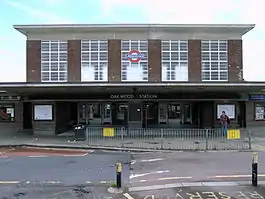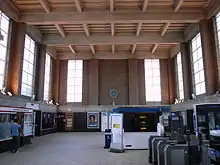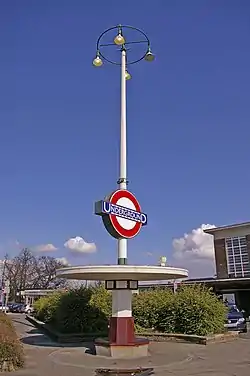Oakwood tube station
Oakwood is a London Underground station on the Piccadilly line. It is the second most northerly station on the line, between Southgate and Cockfosters stations, and is in Travelcard Zone 5. The station is on the edge of the Oakwood area of Enfield (N14) and is situated at the junction of Bramley Road (A110) and Chase Road (the other end of Chase Road is close to Southgate Underground station). This station has step-free access after the upgrades made to the station between October and December 2007.
| Oakwood | |
|---|---|
 | |
 Oakwood Location of Oakwood in Greater London | |
| Location | Oakwood |
| Local authority | Enfield |
| Managed by | London Underground |
| Number of platforms | 2 |
| Accessible | Yes[1] |
| Fare zone | 5 |
| London Underground annual entry and exit | |
| 2015 | |
| 2016 | |
| 2017 | |
| 2018 | |
| 2019 | |
| Railway companies | |
| Original company | London Electric Railway |
| Key dates | |
| 13 March 1933 | Station opened as Enfield West |
| 31 July 1933 | Line extended to Cockfosters |
| 3 May 1934 | Renamed Enfield West (Oakwood) |
| 1 September 1946 | Renamed Oakwood |
| Listed status | |
| Listing grade | II* (since 20 July 2011) |
| Entry number | 1078930[5] |
| Added to list | 19 February 1971 |
| Other information | |
| External links | |
| WGS84 | 51.64750°N 0.13167°W |
History
The station opened on 13 March 1933 as part of the Cockfosters extension, its original name being Enfield West.[6] The station did not appear on the original plans to extend the Piccadilly line beyond Finsbury Park, which only provided for seven additional stations, however it served as the line's terminus for a brief period before Cockfosters station was opened.


The station building is a fine example of the architecture Charles Holden designed for the Piccadilly line extensions, with a large and imposing box-shaped ticket hall surrounded by lower structures containing shops. The ceiling of the booking hall is particularly monumental and bold. The whole design mirrors proportions found in classical architecture, albeit in a distinctly 20th century structure. The dimensions of the ticket hall are approximately a "double-cube" (its front elevation is roughly twice its height and width). The station is similar to Holden's slightly earlier designs for Sudbury Town and Acton Town stations at the western end of Piccadilly line. Oakwood Station is a Grade II* listed building.[7]
Like other extensions of the London Underground lines, the opening of the Cockfosters extension stimulated the rapid development of new suburbs and much of the open countryside that existed in 1930 when construction started was quickly covered by new housing developments.
2006–07 upgrade
In early October 2006 to December 2007, the station underwent an upgrade as part of London Underground's £10billion upgrade to the whole of the London Underground Network. As part of this, a new lift was installed to provide step-free access to the platforms. The Public Address system was also improved, with new information indicators installed on the platforms and inside the ticket hall. In addition 27 new CCTV cameras were installed in the station bringing the total number to 29.
Station name
Before the station opened, the Underground Electric Railways Company of London (forerunner of London Underground) suggested names for it including Oakwood, Merryhills and East Barnet, but it was named Enfield West at opening and renamed Enfield West (Oakwood) the following year.[8]
The station was located in the area of Southgate Council and, following protests from the council, it was eventually renamed Oakwood on 1 September 1946.[8][9]
Operations
Currently a few trains in the early morning and late evening enter/leave service at Oakwood, from Cockfosters Depot (which has an entrance point north of Oakwood station). There is additionally a crossover for trains to reverse, and the possibility of an extra platform built using an existing siding has been mooted to provide extra peak-hour reversing capacity.
Connections
- London Buses routes 121, 307 and 377 serve the station.
References
- "Step free Tube Guide" (PDF). Transport for London. May 2020. Archived (PDF) from the original on 7 August 2020.
- "Multi-year station entry-and-exit figures (2007–2017)" (XLSX). London Underground station passenger usage data. Transport for London. January 2018. Retrieved 22 July 2018.
- "Station Usage Data" (CSV). Usage Statistics for London Stations, 2018. Transport for London. 21 August 2019. Retrieved 27 April 2020.
- "Station Usage Data" (XLSX). Usage Statistics for London Stations, 2019. Transport for London. 23 September 2020. Retrieved 9 November 2020.
- Historic England. "Details from listed building database (1078930)". National Heritage List for England. Retrieved 12 November 2012.
- Rose, Douglas (1999). The London Underground, A Diagrammatic History. Douglas Rose/Capital Transport. ISBN 1-85414-219-4.
- "16 London Underground Stations Listed At Grade II". English Heritage. Archived from the original on 4 January 2015. Retrieved 28 July 2011.
- Harris, Cyril M. (2006) [1977]. What's in a name?. Capital Transport. p. 53. ISBN 1-85414-241-0.
- Wolmar, Christian (2004). "Reaching Out". The Subterranean Railway: How the London Underground Was Built and How It Changed the City Forever. Atlantic Books. p. 229. ISBN 1-84354-023-1.
External links
| Wikimedia Commons has media related to Oakwood tube station. |
- London Transport Museum Photographic Archive
- Junction of Bramley Road and Chase Road, site for new station, September 1930
- Platforms under construction, looking south-east over open countryside, October 1932
- External view of Enfield West station, April 1933
- Ticket hall showing structure supporting concrete roof, April 1933
- View from end of platform of open countryside, July 1934
- Similar view, houses have replaced countryside, August 1936
| Preceding station | Following station | |||
|---|---|---|---|---|
| Piccadilly line | Terminus |